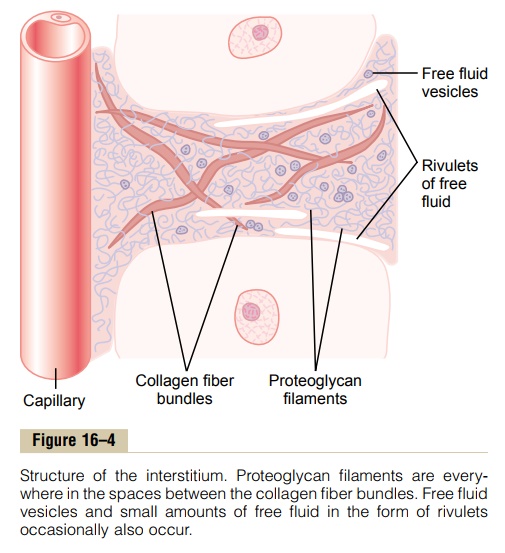Chapter: Medical Physiology: The Microcirculation and the Lymphatic System: Capillary Fluid Exchange, Interstitial Fluid, and Lymph Flow
The Interstitium and Interstitial Fluid

The Interstitium and Interstitial Fluid
About one sixth of the total volume of the body con-sists of spaces between cells, which collectively are called the interstitium. The fluid in these spaces is the interstitial fluid.
The structure of the interstitium is shown in Figure 16–4. It contains two major types of solid structures:
(1) collagen fiber bundles and (2) proteoglycan fila-ments. The collagen fiber bundles extend long dis-tances in the interstitium. They are extremely strong and therefore provide most of the tensional strength of the tissues. The proteoglycan filaments, however, are extremely thin coiled or twisted molecules composed of about 98 per cent hyaluronic acid and 2 per cent protein. These molecules are so thin that they can never be seen with a light microscope and are difficult to demonstrate even with the electron microscope. Nevertheless, they form a mat of very fine reticular fil-aments aptly described as a “brush pile.”

“Gel” in the Interstitium. The fluid in the interstitium isderived by filtration and diffusion from the capillaries. It contains almost the same constituents as plasma except for much lower concentrations of proteins because proteins do not pass outward through the pores of the capillaries with ease. The interstitial fluid is entrapped mainly in the minute spaces among the proteoglycan filaments. This combination of proteo-glycan filaments and fluid entrapped within them has the characteristics of a gel and therefore is calledtissuegel.
Because of the large number of proteoglycan fila-ments, it is difficult for fluid to flow easily through the tissue gel. Instead, it mainly diffuses through the gel; that is, it moves molecule by molecule from one place to another by kinetic, thermal motion rather than by large numbers of molecules moving together.
Diffusion through the gel occurs about 95 to 99 per cent as rapidly as it does through free fluid. For the short distances between the capillaries and the tissue cells, this diffusion allows rapid transport through the interstitium not only of water molecules but also of electrolytes, small molecular weight nutrients, cellular excreta, oxygen, carbon dioxide, and so forth.
“Free” Fluid in the Interstitium. Although almost all thefluid in the interstitium normally is entrapped within the tissue gel, occasionally small rivulets of “free” fluid and small free fluid vesicles are also present, which means fluid that is free of the proteoglycan molecules and therefore can flow freely. When a dye is injected into the circulating blood, it often can be seen to flow through the interstitium in the small rivulets, usually coursing along the surfaces of collagen fibers or sur-faces of cells.
The amount of “free” fluid present in normal tissues is slight, usually much less than 1 per cent. Conversely, when the tissues developedema, these small pocketsand rivulets of free fluid expand tremendously until onehalf or more of the edema fluid becomes freely flowing fluid independent of the proteoglycan filaments.
Related Topics